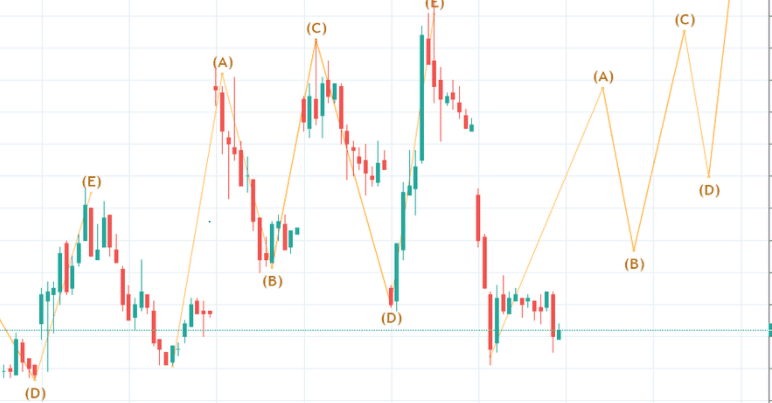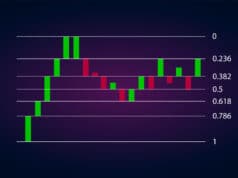Having an abundance of choices is not always helpful. Imagine a kid being in a candy shop where they can only pick two types of candy. How does one know which is good and which is not? The same thing happens in forex trading. There are many currency pairs available, but how can you know which pair is the best for you? In this article, we will dive into features that differentiate currency pairs and how to choose the best pair for your trading goals.
Volatility and liquidity are the characteristics that distinguish currency pairs from each other.
Volatility
Volatility describes how sensitive a currency pair is to a fluctuation in price. Currencies with high volatility have more associated risks; however, the reward is also higher. Conversely, low volatility is a safer option with lower potential rewards.
How can you determine whether a currency pair is volatile?
One simple hack is to open tradingview and analyze the candle charts. An example will be provided below.

Chart 1. Candle Chart of An Asset
To determine short-term volatility, you should analyze individual candles. Specifically, you will need to consider the difference between the highest and lowest price. If this figure is large, then the currency pair is volatile. Low volatility can be seen with a lower difference between the highest and lowest prices.
Over the long term, you should analyze the trends that the candles make. In chart 1, these trends are represented by the yellow lines. Steeper slopes suggest greater changes in price in a shorter period of time. This means that it is more volatile. Lines with less slope represent a currency pair that is less volatile.
Examples of low volatility currency pairs:
Low volatile pairs often involve a major currency.
- AUDUSD
- USDCHF
- USDJPY
- NZDUSD
- EURUSD
- USDCAD
- GBPUSD
Examples of high volatility currency pairs:
These include exotic currencies such as:
- Chinese renminbi
- Indian rupees
- South Korean won
- Mexican peso
- Thai baht
- Russian ruble
- Brazilian real
Liquidity
Liquidity generally refers to the ease of converting assets into cash. This ease is normally measured by the trading volume of this asset. Assets with higher liquidity are safer to invest in and have lower volatility.

Chart 2. Determining Liquidity of an Asset
Chart 2 displays a screenshot of a typical tradingview screen. The red and green bars represent the total volume of trades in a particular time period. The colors, similar to candles, represent whether there has been an increase or decrease in the closing price relative to the opening price. You can also create a line-of-best-fit to look at the average trading volume over a period of time.
Also, it must be noted that there are over-the-counter (OTC) forex trades. These are trades that occur directly between two entities. As a result, prices are usually not publicly disclosed. Most forex brokers are OTC, and you will not be able to see real volume, unlike in FX futures.
So what levels of volatility and liquidity are good for which trading strategy? In order to answer this question, we will split trading strategies into two main time frames: short and long term.
Short-term forex trading
This strategy is mostly used by day-traders, which can open positions that last as little as one minute. You will be expected to catch smaller moves. You might be tempted to look for more volatile, exotic currency pairs. However, the risk of this is it is difficult to find a risk vs. reward ratio due to their big spreads and erratic price action.
Therefore, you will be looking for a few highly volatile currency pairs mixed in with pairs that have lower volatility. If you are employing this strategy, diversify your portfolio with different currency pairs.
Long-term forex trading
This approach involves an open position that lasts for months. Therefore, you will be looking for currency pairs that have low volatility. These long-term trades are made when there is a relatively clear trend in the prices between currencies due to an external factor such as trade or border conflicts. Having low volatility will protect you from having the gains in your trades wiped out due to an instantaneous change in market sentiments.
The recommended currency pairs need to include at least a major currency, preferably the USD, as it is considered one of the safest and most stable currencies. Some examples of major currency are mentioned above in the ‘high volatility currency pairs’ section.
Ending remarks
In order to choose the best currency pair for your trading goals, you need to begin understanding its volatility and liquidity. Then you will need to match them with the length of your trading strategy. One simple trick to remember is: volatility has an inverse relationship with time, whereas liquidity has a positive relationship with time.
For example, if you want to open a position for a longer period of time, you should pick a currency pair that includes a major currency such as EURUSD. The trends will form based on the political-economical situation of each region, and the pair has relatively low volatility, so the market isn’t likely to experience wild swings.




